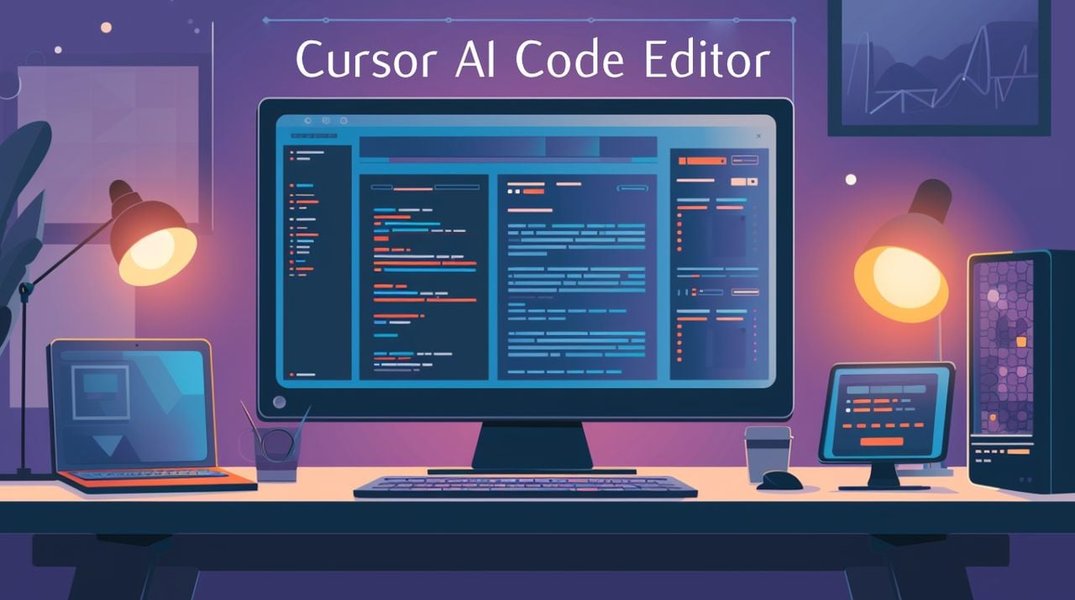
Unlock Your Frontend Potential: AI Tools to Supercharge Your Basic Coding Skills!
Discover AI assistants that can transform your beginner frontend knowledge into practical development power in 2025.
If you're starting your journey into frontend development with just the basics under your belt, you're in luck! The landscape of AI tools in 2025 is rich with assistants designed to help you learn faster, code more efficiently, and bring your web ideas to life. These tools can act as patient mentors, smart collaborators, and tireless assistants, significantly bridging the gap between foundational knowledge and creating functional, appealing user interfaces.
Key Highlights: AI for Frontend Beginners
- Code Generation from Simple Inputs: Many AI tools can take your text descriptions, sketches, or even images and generate HTML, CSS, and JavaScript code, helping you visualize and understand how UI elements are built.
- Intelligent Assistance & Learning: AI offers real-time code suggestions, error detection, and explanations for complex code snippets, making the learning process more interactive and less intimidating.
- Workflow Acceleration: By automating repetitive tasks and providing boilerplate code, AI tools allow you to focus on understanding core frontend concepts and design principles, rather than getting bogged down in syntax.
Top AI Tools to Elevate Your Frontend Coding Game
Navigating the world of frontend development (HTML, CSS, JavaScript, and frameworks like React, Vue, or Tailwind CSS) can be challenging with only basic knowledge. AI tools can simplify this journey. Here’s a look at some of the best AI assistants tailored for beginners in 2025:

A typical frontend development environment where AI tools can be integrated.
Tools for Visual Learners & Rapid Prototyping
These tools are excellent if you prefer to see your ideas take shape quickly or want to translate visual designs into code with minimal manual effort.
Webcrumbs Frontend AI
Why it's great for beginners: Webcrumbs allows you to generate UI components from images, text descriptions, or screenshots. This is incredibly useful for understanding how visual designs translate into actual code (React, Tailwind CSS, or HTML).
Key Features for Beginners:
- Intuitive online platform, often requiring no login to start.
- Instantly converts design ideas into usable frontend code snippets.
- Helps learn practical coding structures by providing clear examples.
v0 by Vercel
Why it's great for beginners: If you want to see an entire webpage materialize from a simple text prompt, v0 is a game-changer. It handles code structure, styling, and responsive design automatically.
Key Features for Beginners:
- Generates React-based projects with live previews from natural language descriptions (e.g., "create a landing page with a newsletter signup form").
- Essentially a no-code to low-code solution for generating initial frontend structures.
Cursor
Why it's great for beginners: Cursor is an AI-powered code editor that provides an interactive coding experience. Its ability to offer real-time previews of frontend code helps beginners immediately see the visual impact of their code.
Key Features for Beginners:
- Allows natural language prompts to write or modify code.
- AI agents can update entire classes or functions with explanations.
- The visual feedback loop is invaluable for understanding the relationship between code and UI.

Interface of an AI-powered code editor like Cursor, aiding in frontend development.
Tools for Code Assistance, Completion, and Learning
These tools integrate into your coding environment or act as standalone assistants to help you write code, understand it better, and catch errors.
GitHub Copilot
Why it's great for beginners: As one of the most popular AI pair programmers, GitHub Copilot provides real-time code suggestions as you type. It's excellent for generating boilerplate code and learning best practices for HTML, CSS, JavaScript, React, and Vue.
Key Features for Beginners:
- Intelligent autocompletion reduces the amount of code you need to write from scratch.
- Can explain code snippets in simple terms, aiding comprehension.
- Integrates seamlessly with popular IDEs like Visual Studio Code.
Codeium
Why it's great for beginners: Codeium stands out as a powerful and often free alternative for real-time code suggestions and summaries. It can break down complex code into simpler explanations, which is fantastic for learning.
Key Features for Beginners:
- Offers robust autocompletion for frontend languages and frameworks.
- AI-powered summaries explain code functionality in plain language.
- Helps identify and fix common errors, crucial for beginners.
- Many core features are available for free.
Tabnine
Why it's great for beginners: Tabnine provides AI-powered autocompletion with a strong focus on privacy. It suggests code blocks relevant to your current context, helping you write simple HTML structures or CSS animations more quickly.
Key Features for Beginners:
- Context-aware code completions speed up typing and suggest corrections.
- Supports numerous languages including JavaScript, CSS, and HTML.
- Offers a secure environment for experimentation.
Claude AI
Why it's great for beginners: Claude AI is lauded for its strong reasoning and explanation capabilities. It can take basic descriptions and generate clean, understandable frontend code with step-by-step breakdowns, making it an excellent learning companion.
Key Features for Beginners:
- Excels at generating and explaining frontend code (e.g., responsive layouts in Tailwind CSS, debugging JavaScript).
- Supports natural language inputs for code generation.
- Can provide interactive prototypes or artifacts to visualize changes.
Tools for Project Scaffolding and Automation
Replit AI
Why it's great for beginners: Replit AI allows you to describe an application idea in natural language, and it will attempt to generate the corresponding frontend (and potentially backend) code. This is great for prototyping and learning by seeing how your requests translate into code.
Key Features for Beginners:
- Translates descriptions into actual code which can be tweaked and studied.
- Good for quick prototyping and hands-on learning.
Taskade AI Front-End Code Generator
Why it's great for beginners: Taskade offers a straightforward way to get started on frontend projects. You describe what you want to create, and it generates foundational code.
Key Features for Beginners:
- Users can provide instructions, upload source material, or use dropdowns to guide code generation.
- Helps scaffold projects, providing a starting point for beginners.
MutableAI
Why it's great for beginners: While also offering code generation, MutableAI has a strong focus on refactoring and optimizing existing code. As a beginner, this can help you understand how to improve your code quality and adhere to best practices.
Key Features for Beginners:
- Automated code improvements and test generation.
- Helps learn about code efficiency and maintainability.
Comparing AI Frontend Tools for Beginners
To help you choose, here's a comparative look at some of the highly recommended tools for beginners. This radar chart visualizes their strengths across key aspects relevant to someone starting with basic frontend knowledge. The scores are based on general capabilities and beginner-friendliness, where a higher score indicates better performance in that specific area for a novice user.
This chart highlights that tools like Webcrumbs and v0 by Vercel excel in ease of use and natural language input, making them very accessible for beginners. GitHub Copilot and Codeium offer strong IDE integration and learning support, while Cursor shines in visual prototyping capabilities.
Visualizing the AI-Assisted Frontend Workflow for Beginners
Understanding how these AI tools fit into your learning and development process can be helpful. This mindmap illustrates a typical workflow where AI assists at various stages, from conceptualization to functional code.
This mindmap shows that AI can be a partner throughout the frontend development lifecycle for a beginner, from turning an initial idea into code, assisting in writing and refining that code, helping understand complex parts, and even aiding in debugging.
Quick Comparison Table: Top Picks for Beginners
Here's a simplified table highlighting a few top AI tools and their key strengths for beginners in frontend development:
| Tool | Primary Strength for Beginners | Key Feature | Learning Support | Typical Use Case |
|---|---|---|---|---|
| Webcrumbs Frontend AI | Visual to Code Generation | Generates UI from images/text | Learn by example from generated code | Quickly create components based on design ideas |
| GitHub Copilot | Code Completion & Explanation | Real-time suggestions in IDE | Explains code snippets, suggests best practices | Daily coding assistance, reducing boilerplate |
| Codeium | Free & Comprehensive Assistance | Autocomplete, code summarization | Explains code, helps fix errors | Learning syntax, understanding existing codebases |
| Cursor | Interactive Development & Visual Feedback | AI editor with live previews | Understand code-to-UI relationship | Visually iterating on frontend designs |
| v0 by Vercel | Full Page Generation from Prompts | Natural language to React UIs | See how complex pages are structured | Rapidly scaffolding entire landing pages or UIs |
Video: AI in Frontend Development
To see some of these concepts in action, the following video provides a good overview of how AI is being used in frontend development. While it may cover a range of tools and techniques, it can give you a better sense of the current capabilities and how they might assist someone with basic knowledge.
This video, "Only AI Frontend Coding Tutorial You Will Ever Need," demonstrates building frontend components with AI, offering valuable insights for beginners.
Watching tutorials like this can help you understand the practical application of AI tools and inspire you to try them out for your own projects. It often showcases how to prompt the AI effectively and integrate its outputs into a working application.
Tips for Beginners Using AI Frontend Tools
- Start Simple: Begin with tools that offer natural language UIs or image-to-code features (like Webcrumbs or v0) to build confidence and see immediate results.
- Learn Actively: Don't just copy-paste AI-generated code. Study it, try to understand why it's written that way, and experiment by tweaking it. Use AI's explanation features.
- Use AI as a Guide, Not a Crutch: AI can help with syntax and boilerplate, but focus on understanding the underlying frontend principles (HTML structure, CSS specificity, JavaScript logic).
- Integrate into Your Workflow: Use AI assistants that plug into your preferred code editor (like GitHub Copilot or Codeium in VS Code) for a smoother experience.
- Combine Tools: You might use one tool (e.g., Webcrumbs) to generate initial components and another (e.g., Tabnine or GitHub Copilot) to refine and complete your code.
- Practice Regularly: The more you use these tools on small projects, the better you'll become at leveraging them and at frontend coding itself.
Frequently Asked Questions (FAQ)
Recommended Next Searches
- How to effectively learn frontend development using AI code generation tools.
- Best practices for integrating AI suggestions into existing frontend projects.
- Comparing AI code assistants for React versus Vue development for beginners.
- How can AI tools help debug common JavaScript errors in frontend applications.
References
Last updated May 6, 2025